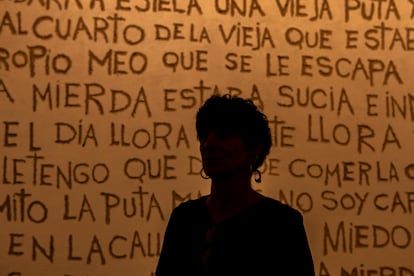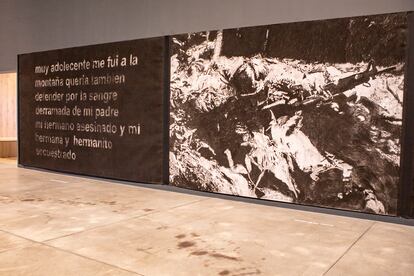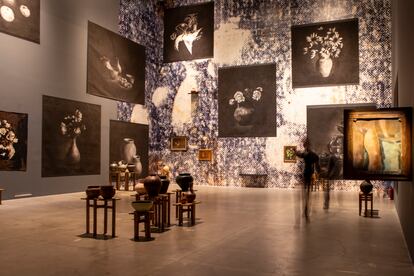Ana Gallardo (Rosario, Argentina, 66 years old) decided to help the guerrilla cause in Guatemala in the midst of the military dictatorship in the 1980s. The woman who came from a nun’s education during Franco’s time in Spain, whose grandmother died in a bombing and who lost uncles in that civil war, who suffered with her family under the Argentine dictatorship, clandestinely joined the struggle in the Central American country with the idea of ”changing the world.” She remembers this in a conversation that takes place under the warm sun of late summer on a terrace of the Museo Universitario de Arte Contemporáneo (MUAC), in Mexico City, where at the beginning of August she inaugurated a retrospective of her work. “When I remember it I say to myself: ‘How crazy.’ What youth is and above all naivety,” she says smiling.
The Argentine artist has achieved recognition in the world of contemporary art. This summer she exhibited a retrospective in Spain and the MUAC has now brought together in its exhibition A delirium trembled hereavailable until December 15, 20 years of artistic production. The museum has defined it as “the need to make mourning a public process from a perspective that puts the open wound of violence against women at the center.”
Among the works included in the exhibition is one about that experience in Guatemala, which attempts to capture the story of the women who participated in the guerrilla struggle. She created it with the help of María Us, a woman of Quiché origin whose father was kidnapped and murdered by the Guatemalan Army in 1982, two of her brothers disappeared and later her husband was killed. María told her that she and her companions had fallen into oblivion and that is when Gallardo decided to create a work that pays tribute to them, but that also helps them heal their own wounds, because for Gallardo art has been healing. “At that moment I thought: I want to be a tool for justice for what I saw happening, coming from an Argentina that was already in democracy, where we understood the Mothers of Plaza de Mayo, the disappeared. So I started to collaborate in a clandestine way, a very strange accompaniment, but profound for me,” she explains.
The work is overwhelming and a way of recovering the memory of that terrible genocide led by sinister characters such as the former dictator Efraín Ríos Montt. “Six or seven years ago I began to reflect on that, but I couldn’t do it alone. I won a scholarship to go on a trip that proposed an investigation into the failure of utopias. I wanted to go and look for these women from the clandestine struggle. I thought I would never find them because I realized I didn’t know their names, but suddenly María Us appeared and together we were able to make the trip, we talked, we built this whole piece, from her pain and mine,” explains Gallardo.
It is a way of giving voice to those women who fought for a more just country from clandestinity and anonymity. “What María says, and what one realizes happens in every revolutionary movement, is that there were very few visible women. In Cuba, when you talk to the women of the revolution, they tell you ‘there was no machismo here’. And yes! Some really were revolutionary leaders, the rest were the teachers, the educators, the nurses. When you read the history of the Mexican Revolution and the role of women in the revolution, you realize that they were caregivers. That is very important, because this revolution would not have been carried out without them, but in the memory of humanity it is as if they did not exist. They were killed, raped, they carried their metate on their shoulders to feed people. The memory of what the role of women is is very violent,” she says.
The Argentine artist lives and works in Mexico. Her studio is in Santa María la Ribera, a beautiful neighbourhood in the centre of the city still full of stately homes with French-style architecture and lush gardens, but which, like the rest of this fashionable capital, is suffering the ravages of gentrification. In her house she has an “impressive” altar, she says, “everything is there, even the black butterflies,” she says, laughing with a frank, easy, contagious laugh. Does this come from her education with nuns? Gallardo says that there is something in her from that religious preparation when she was a child in a school in the north of Spain, but she says between laughs: “I hate them with all my heart.” “We are talking about Franco, Francoist nuns, disgusting, horrible,” she explains. She says that as a teenager she dreamed of taking revenge, smoking and blowing smoke in their faces. “It is like the revenge of the bad girl, like Almodóvar. I love Almodóvar. I am an Almodóvar girl.” “I would have loved for him to discover me for a character,” he jokes.

The Argentine artist fights against the system that makes women invisible, that pushes them aside when they get older, that is capable of forgetting or erasing them. And she stands against the taboos that still mark the pace in an artistic system that has only just begun to recognize their legacy. This artist who works to create networks with other women and denounce the open wound of violence that separates them, kills them or kidnaps them, talks about old age, feminism and the fight for equality (Gallardo uses inclusive language that has achieved an important space in Argentina), her commitment and her art.
Ask. You have said that you are afraid of getting older. Why?
Answer. I am afraid of deterioration, of loneliness, I am afraid of dying. I am afraid of knowing that I have at most, with great fury, because I am strong, 15 years of useful life. I cannot bear physical deterioration and I am very afraid of isolation, of what society causes, of society’s rejection of us old women.
P. Does art help you cope with that fear?
R. Yes. Art and getting involved in the subject. When I started working on this subject 20 years ago, it helped me heal things, inheritances, because my father was also terrified of death. I am very similar to him. That transition helps me to recompose myself into what I am, not that I accept it, because I am in internal struggles all day long.
P. What kind of struggles?
R. Let old age not be a space of invisibility in a society that pushes us out of the way.
P. Here at the MUAC there is an exhibition of Myra Landau, whose work has long been forgotten. Are women artists still treated with the same disdain?
R. I think so. Myra was a visible woman who falls into oblivion, but she was a woman who, within her context here in Mexico, had a certain place of power. I understand, from what I was talking to colleagues of that same generation, that she was a woman who worked on a sensitive geometry that the men of that time despised, denigrated, because geometry was harder. I think that exactly the same thing continues to happen, perhaps a little less, because it has become fashionable to recover historical women like her or, in quotes, like me, who am not yet completely old. The system now needs women of this age range.

P. There are other artists who have been turned into merchandise, like Frida Khalo.
R. Yes, although not all of us manage to achieve it. Frida Khalo is the only one who manages to be that commodity, because it is not like one wants to fight with the market. In Argentina there is an icon for me called Elda Cerrato, who is an artist who was exiled in Venezuela, a beautiful woman, with an impressive body of work, and they rescue her, which also seems super patriarchal to me, they rescue her when she is already old, over 80 years old, and they do a retrospective, she starts selling, she wins the Velázquez Prize in Spain and she dies. When I met her in Argentina she said to me: ‘And now what for?’ And the business is not even for her, it is for the galleries that keep her work. We cannot enjoy a comfortable life, because recognition does not come to us at the moment when we can go out and buy a pair of tight pants that look beautiful on us.
P. Is it a matter of fashion, of how good it looks to give more space to women in the arts? Is it a matter of filling quotas?
R. I think it’s all in one. And also an outstanding debt, because the system clearly realizes that it was wrong. I think a lot about an artist like the Chilean Cecilia Vicuña, who is also now the most important Latin American artist in the history of art, who luckily is super active and tremendous. It’s good that the system understands that when they didn’t see her they were missing out on something very powerful because of a stupid head, because this was art made by men: intelligent, profound, cultured, with reference to philosophy. And she is a woman of the earth, working with poetry, and the system ignored that all her life, but now they realize that they were wrong.
P. You have claimed that your mother, a painter, was unable to devote herself fully to art, as she wanted, precisely because of this patriarchal system. She died when you were seven years old. How has this loss affected you?
R. It left a mark on me. Her death forced me to look into her. I am the product of the desire of this woman, who was also my mother, a frustrated artist. And all my work, when I see it, I say: of course, it’s her. All these women I look for, with whom I have worked, are all possible mothers.
P. Could this be interpreted as revenge on his part towards his mother?
R. Yes, revenge. I like the word revenge better. A revenge from her, from myself and from many others, because I feel that many times in the art system I have not had a good time, when I did not achieve the goals I wanted. I suffered jealousy, envy, frustrations, all those things that leave a mark on you, that leave a wound.
P. You live in Mexico and work here, a country where 11 women are killed every day and many disappear. How do you deal with this sexist reality?
R. With collective work, support networks. Sometimes in times of great commitment, other times less, because I am already an older woman, I am already retired.
P. Do you think that a woman in the presidency can improve the conditions of women?
R. Yes, I do. I think that Cristina Kirchner, in Argentina, improved a lot and made all the laws possible for us women without being a feminist, because she does not recognize herself as a feminist, she did not enact the Abortion Law. I love her, she is my idol. She made a lot of laws and favored the worker, the female worker, the male workers. She promoted equal marriage and a lot of rights for the people. And that was done by a woman. Here we hope that it works with Claudia Sheinbaum, that she understands what López Obrador did not understand with women, although he has given them his pension. Clearly there are a lot of improvements for the people, and I hope that she doubles down.
P. In the case of Argentina, do you fear that under Milei’s government there will be a regression in the rights achieved by women?
R. Yes. The level of regression is impressive. It closed the organizations that were opened not only for women, but for childrenthe dissidents. Cristina gave retirement to housewives, she recognized that the work of caring had never been recognized. What does Milei care, if she hates her mother? And it is slave work, because the most harmful work there is is that of the home. Evidently they are destroying a country for the convenience of five rich people.
P. In times like these, can art be resistance?
R. Before I could have told you that yes, art was a form of resistance. The arts in general can give you tools to understand how you have to carry out your resistance, because you can meet people with whom you understand that together we can think about the future.
Sign up for the free EL PAÍS Mexico newsletter and to WhatsApp channel and receive all the latest news on current events in this country.

